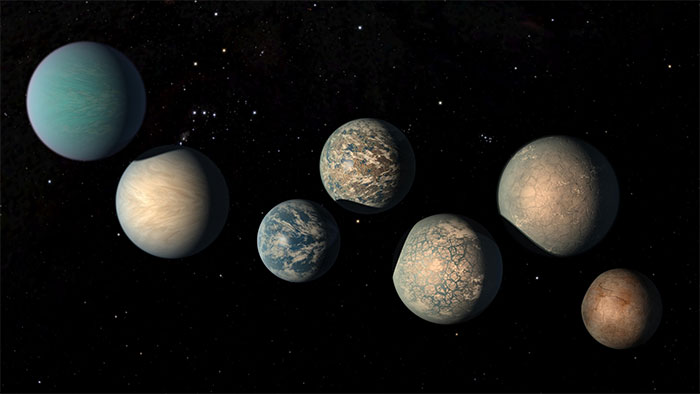US detects radio signals from 7 planets similar to Earth
A new technique for detecting alien radio signals has been applied to the TRAPPIST-1 system.
Scientists from two American research institutions, Pennsylvania State University and the SETI Institute (Search for Extraterrestrial Intelligence), have found a new way to detect signals from future alien civilizations.
In an experiment recently published in the Astronomical Journal , the famous star system TRAPPIST-1 was scanned for 28 hours using the Allen Telescope Array using a new method.
They searched across a wide frequency range, detecting narrowband signals, which were considered signs that could come from alien technology.

Seven special planets in the TRAPPIST-1 system - (Graphic image: NASA).
The 11,000 most promising signals were filtered out for a second-step analysis, in which the researchers focused on a phenomenon called interplanetary occultation, which occurs when one planet moves in front of another.
If intelligent life existed in that star system, disruptions in radio signals sent between planets could be detected from Earth.
Ultimately, 2,264 signals that could indicate interplanetary eclipses were filtered out. However, in this search, none of the signals were determined to be of alien origin.
However, the researchers believe that the most important thing is that they have found a method , a suitable direction for the hunt for alien civilizations.
Because the failure of the TRAPPIST-1 star system was not unexpected, according to Sci-News.
TRAPPIST-1 is located 38.8 light years from Earth, consisting of 7 planets orbiting an extremely cool dwarf star.
Interestingly, any planet in this system has some similarities to Earth, some even being similar in size and environment.
There are some factors that get in the way, though : Radiation from the parent star might be too high, some planets are tidally locked to their parent star, and others have too much water.
Scientists don't expect to find aliens capable of building civilizations on these worlds, but they believe that some of the planets in TRAPPIST-1 may still harbor microbial life.
- Mysterious radio signals from the universe
- AI detects 72 radio signals from the universe
- Telescope Australia detects more mysterious radio signals
- Giant telescope captures signals from the universe
- The mysterious, inexplicable signals from space
- Mysterious signals from deep space are repeated in a 16-day cycle
- The mysterious radio signal was identified as originating from the universe
- Earth catches strange radio signal flashing from the 'monster' black hole
- Dead planets may be signaling in outer space
- The earth is getting strange signals from bubble objects
- The strong signal sent to us comes from the Earth itself
- The alien signal constantly bounces off the Earth every second
 Van Allen's belt and evidence that the Apollo 11 mission to the Moon was myth
Van Allen's belt and evidence that the Apollo 11 mission to the Moon was myth The levels of civilization in the universe (Kardashev scale)
The levels of civilization in the universe (Kardashev scale) Today Mars, the sun and the Earth are aligned
Today Mars, the sun and the Earth are aligned The Amazon owner announced a secret plan to build a space base for thousands of people
The Amazon owner announced a secret plan to build a space base for thousands of people